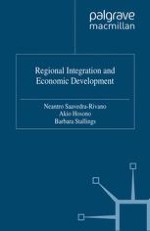2001 | OriginalPaper | Buchkapitel
The Role of Free Trade Agreements in Chile’s Development Strategy
verfasst von : Manuel R. Agosín
Erschienen in: Regional Integration and Economic Development
Verlag: Palgrave Macmillan UK
Enthalten in: Professional Book Archive
Aktivieren Sie unsere intelligente Suche, um passende Fachinhalte oder Patente zu finden.
Wählen Sie Textabschnitte aus um mit Künstlicher Intelligenz passenden Patente zu finden. powered by
Markieren Sie Textabschnitte, um KI-gestützt weitere passende Inhalte zu finden. powered by
Ever since the military coup of September 1973, trade liberalization, and within that context, export-oriented growth, have been cornerstones of Chilean development policy. One of the first measures of the military government after the September 1973 coup was to announce a trade policy reform. Indeed, at that time trade policy can best be described as chaotic: the (unweighted) average tariff was 94 per cent; there were 57 different tariff rates, ranging from zero to 220 per cent (plus surcharges on a number of items); there were many non-tariff measures (prior import deposits, prohibitions, quotas, etc) and a multiple exchange rate system with eight rates, where the highest price for the dollar was 10 times the lowest. This ad hoc system of protection served no development purpose at all. The disorganization of the Allende period had led to stagnation in manufacturing, the disappearance of economic growth, and a strong contraction of a fledgling non-traditional export sector (which included several manufactures). The trade liberalization announced in late 1973 involved the elimination of all non-tariff barriers, the gradual reduction of tariff rates and their consolidation into three tariff levels (with a maximum rate of 60 per cent), and the unification of the exchange rate. In June 1979, a flat tariff of 10 per cent was established. Although the level did experience an increase in 1982 through 1985, as a response to the effects of the debt crisis, it soon resumed its downward course and now stands at 11 per cent (for details, see Ffrench-Davis, Leiva, and Madrid, 1991).
